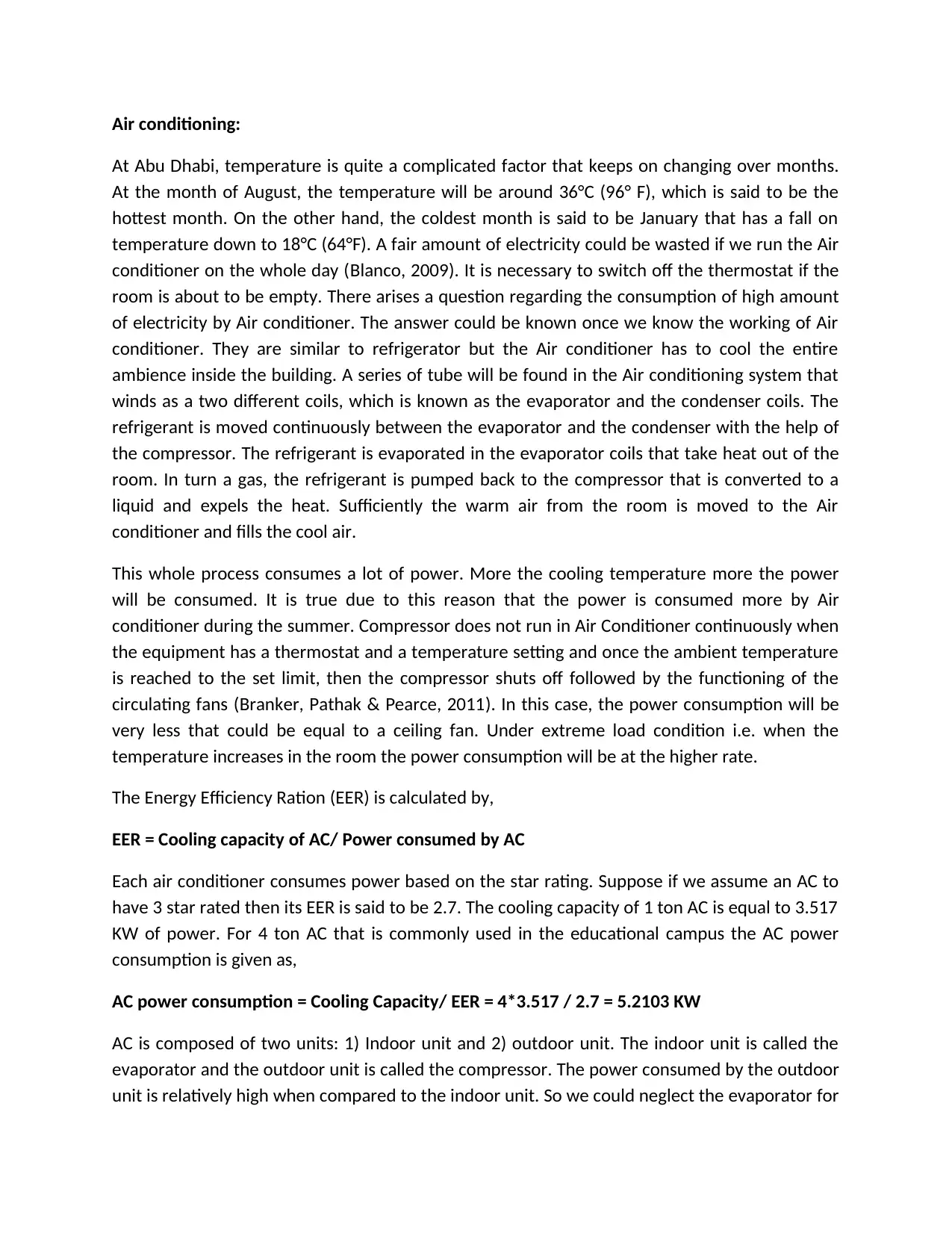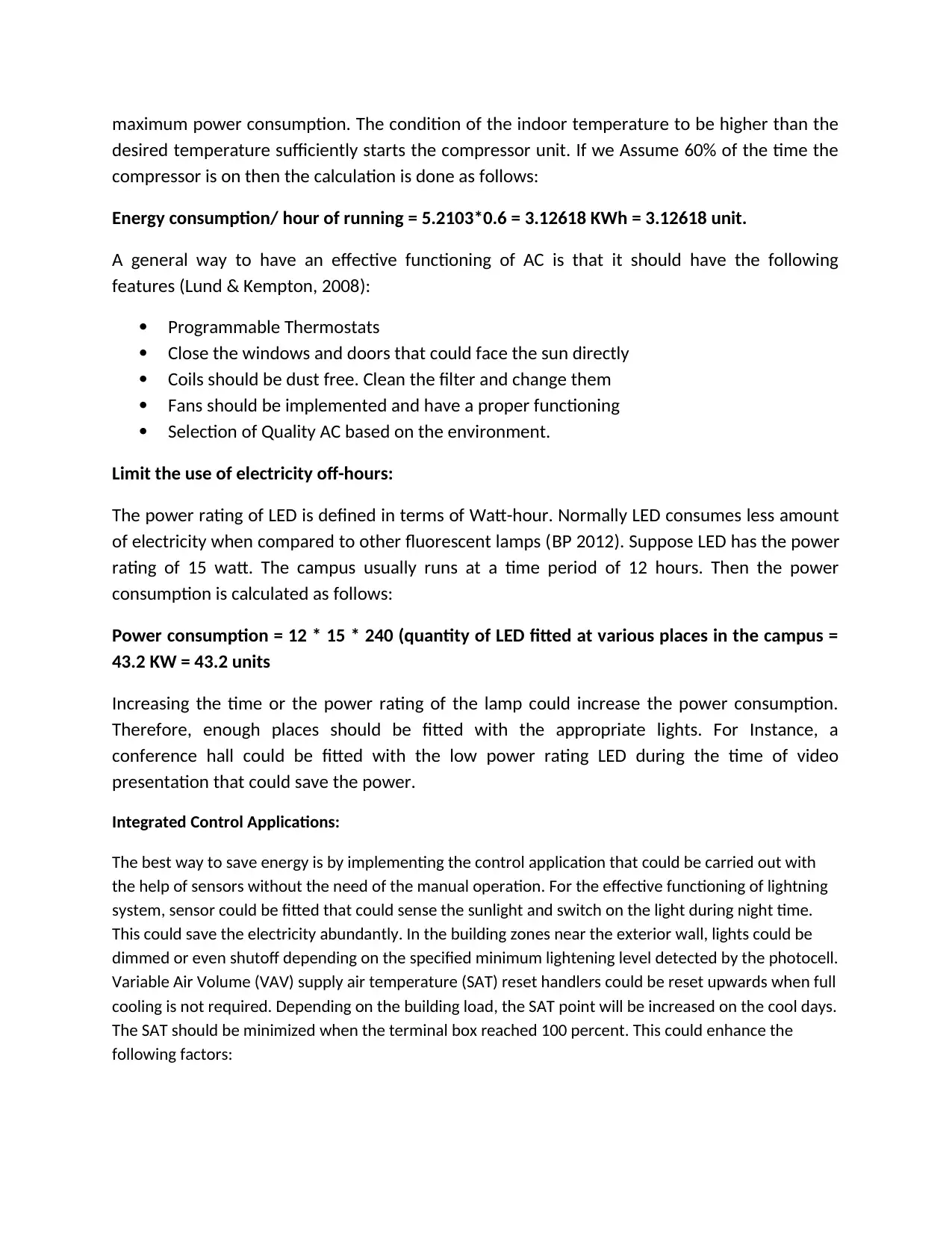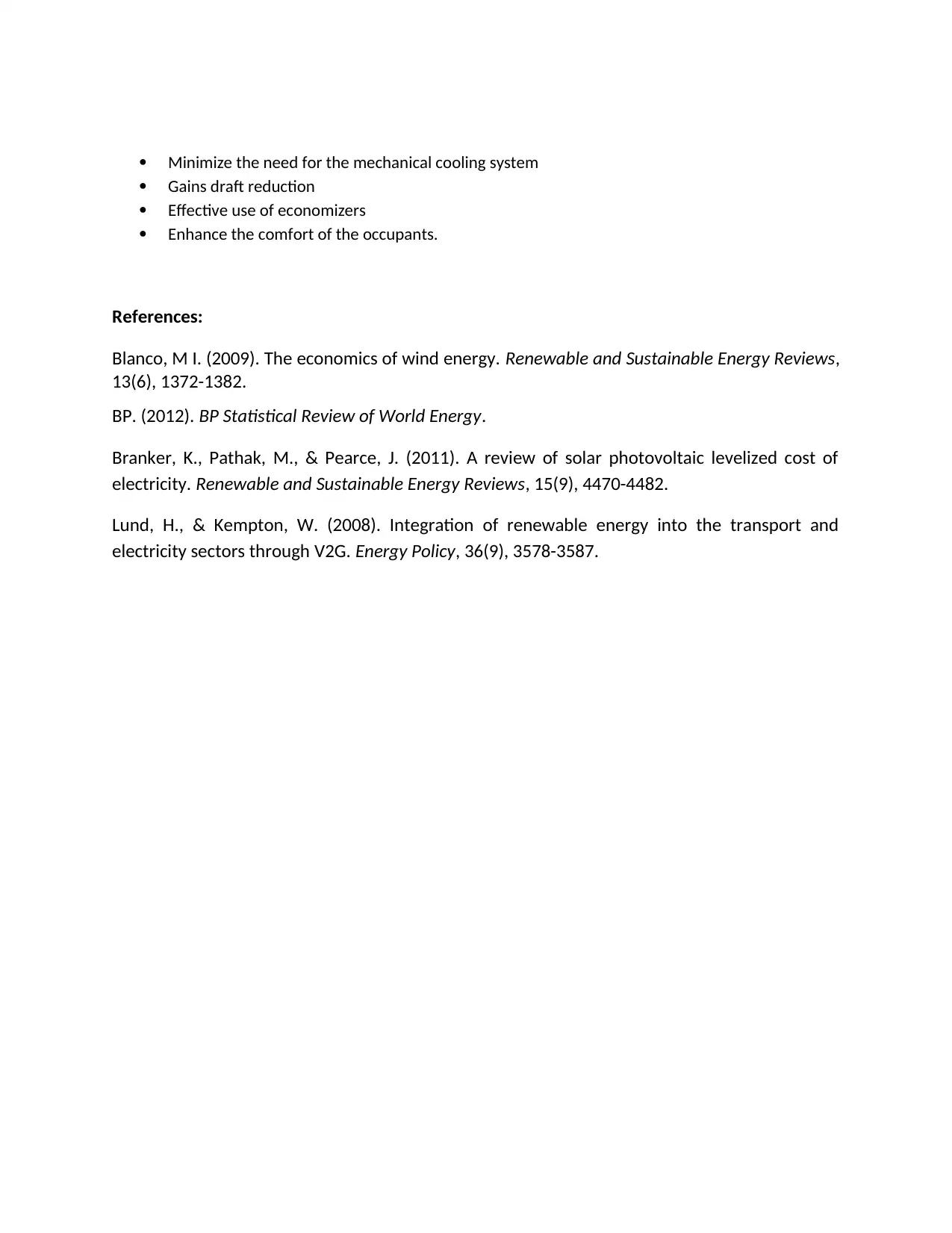Energy Resources Management: SUAD Campus Reduction Strategic Plan
VerifiedAdded on 2023/05/29
|3
|1148
|173
Report
AI Summary
This report addresses the urgent need for energy resource management at Sorbonne University Abu Dhabi, in response to global environmental concerns. It explores practical strategies for reducing energy consumption on campus without disrupting essential operations. The report analyzes the energy consumption of air conditioning systems, highlighting the impact of thermostat settings and the potential for energy savings through efficient usage and programmable thermostats. It also examines the power consumption of LED lighting, advocating for optimized usage and sensor-based control systems. Furthermore, the implementation of integrated control applications and Variable Air Volume (VAV) systems are discussed as effective methods to minimize mechanical cooling needs, enhance comfort, and maximize energy savings. The report references relevant studies and proposes a roadmap for implementing these strategies to achieve significant energy reduction at the university.

Air conditioning:
At Abu Dhabi, temperature is quite a complicated factor that keeps on changing over months.
At the month of August, the temperature will be around 36°C (96° F), which is said to be the
hottest month. On the other hand, the coldest month is said to be January that has a fall on
temperature down to 18°C (64°F). A fair amount of electricity could be wasted if we run the Air
conditioner on the whole day (Blanco, 2009). It is necessary to switch off the thermostat if the
room is about to be empty. There arises a question regarding the consumption of high amount
of electricity by Air conditioner. The answer could be known once we know the working of Air
conditioner. They are similar to refrigerator but the Air conditioner has to cool the entire
ambience inside the building. A series of tube will be found in the Air conditioning system that
winds as a two different coils, which is known as the evaporator and the condenser coils. The
refrigerant is moved continuously between the evaporator and the condenser with the help of
the compressor. The refrigerant is evaporated in the evaporator coils that take heat out of the
room. In turn a gas, the refrigerant is pumped back to the compressor that is converted to a
liquid and expels the heat. Sufficiently the warm air from the room is moved to the Air
conditioner and fills the cool air.
This whole process consumes a lot of power. More the cooling temperature more the power
will be consumed. It is true due to this reason that the power is consumed more by Air
conditioner during the summer. Compressor does not run in Air Conditioner continuously when
the equipment has a thermostat and a temperature setting and once the ambient temperature
is reached to the set limit, then the compressor shuts off followed by the functioning of the
circulating fans (Branker, Pathak & Pearce, 2011). In this case, the power consumption will be
very less that could be equal to a ceiling fan. Under extreme load condition i.e. when the
temperature increases in the room the power consumption will be at the higher rate.
The Energy Efficiency Ration (EER) is calculated by,
EER = Cooling capacity of AC/ Power consumed by AC
Each air conditioner consumes power based on the star rating. Suppose if we assume an AC to
have 3 star rated then its EER is said to be 2.7. The cooling capacity of 1 ton AC is equal to 3.517
KW of power. For 4 ton AC that is commonly used in the educational campus the AC power
consumption is given as,
AC power consumption = Cooling Capacity/ EER = 4*3.517 / 2.7 = 5.2103 KW
AC is composed of two units: 1) Indoor unit and 2) outdoor unit. The indoor unit is called the
evaporator and the outdoor unit is called the compressor. The power consumed by the outdoor
unit is relatively high when compared to the indoor unit. So we could neglect the evaporator for
At Abu Dhabi, temperature is quite a complicated factor that keeps on changing over months.
At the month of August, the temperature will be around 36°C (96° F), which is said to be the
hottest month. On the other hand, the coldest month is said to be January that has a fall on
temperature down to 18°C (64°F). A fair amount of electricity could be wasted if we run the Air
conditioner on the whole day (Blanco, 2009). It is necessary to switch off the thermostat if the
room is about to be empty. There arises a question regarding the consumption of high amount
of electricity by Air conditioner. The answer could be known once we know the working of Air
conditioner. They are similar to refrigerator but the Air conditioner has to cool the entire
ambience inside the building. A series of tube will be found in the Air conditioning system that
winds as a two different coils, which is known as the evaporator and the condenser coils. The
refrigerant is moved continuously between the evaporator and the condenser with the help of
the compressor. The refrigerant is evaporated in the evaporator coils that take heat out of the
room. In turn a gas, the refrigerant is pumped back to the compressor that is converted to a
liquid and expels the heat. Sufficiently the warm air from the room is moved to the Air
conditioner and fills the cool air.
This whole process consumes a lot of power. More the cooling temperature more the power
will be consumed. It is true due to this reason that the power is consumed more by Air
conditioner during the summer. Compressor does not run in Air Conditioner continuously when
the equipment has a thermostat and a temperature setting and once the ambient temperature
is reached to the set limit, then the compressor shuts off followed by the functioning of the
circulating fans (Branker, Pathak & Pearce, 2011). In this case, the power consumption will be
very less that could be equal to a ceiling fan. Under extreme load condition i.e. when the
temperature increases in the room the power consumption will be at the higher rate.
The Energy Efficiency Ration (EER) is calculated by,
EER = Cooling capacity of AC/ Power consumed by AC
Each air conditioner consumes power based on the star rating. Suppose if we assume an AC to
have 3 star rated then its EER is said to be 2.7. The cooling capacity of 1 ton AC is equal to 3.517
KW of power. For 4 ton AC that is commonly used in the educational campus the AC power
consumption is given as,
AC power consumption = Cooling Capacity/ EER = 4*3.517 / 2.7 = 5.2103 KW
AC is composed of two units: 1) Indoor unit and 2) outdoor unit. The indoor unit is called the
evaporator and the outdoor unit is called the compressor. The power consumed by the outdoor
unit is relatively high when compared to the indoor unit. So we could neglect the evaporator for
Paraphrase This Document
Need a fresh take? Get an instant paraphrase of this document with our AI Paraphraser

maximum power consumption. The condition of the indoor temperature to be higher than the
desired temperature sufficiently starts the compressor unit. If we Assume 60% of the time the
compressor is on then the calculation is done as follows:
Energy consumption/ hour of running = 5.2103*0.6 = 3.12618 KWh = 3.12618 unit.
A general way to have an effective functioning of AC is that it should have the following
features (Lund & Kempton, 2008):
Programmable Thermostats
Close the windows and doors that could face the sun directly
Coils should be dust free. Clean the filter and change them
Fans should be implemented and have a proper functioning
Selection of Quality AC based on the environment.
Limit the use of electricity off-hours:
The power rating of LED is defined in terms of Watt-hour. Normally LED consumes less amount
of electricity when compared to other fluorescent lamps (BP 2012). Suppose LED has the power
rating of 15 watt. The campus usually runs at a time period of 12 hours. Then the power
consumption is calculated as follows:
Power consumption = 12 * 15 * 240 (quantity of LED fitted at various places in the campus =
43.2 KW = 43.2 units
Increasing the time or the power rating of the lamp could increase the power consumption.
Therefore, enough places should be fitted with the appropriate lights. For Instance, a
conference hall could be fitted with the low power rating LED during the time of video
presentation that could save the power.
Integrated Control Applications:
The best way to save energy is by implementing the control application that could be carried out with
the help of sensors without the need of the manual operation. For the effective functioning of lightning
system, sensor could be fitted that could sense the sunlight and switch on the light during night time.
This could save the electricity abundantly. In the building zones near the exterior wall, lights could be
dimmed or even shutoff depending on the specified minimum lightening level detected by the photocell.
Variable Air Volume (VAV) supply air temperature (SAT) reset handlers could be reset upwards when full
cooling is not required. Depending on the building load, the SAT point will be increased on the cool days.
The SAT should be minimized when the terminal box reached 100 percent. This could enhance the
following factors:
desired temperature sufficiently starts the compressor unit. If we Assume 60% of the time the
compressor is on then the calculation is done as follows:
Energy consumption/ hour of running = 5.2103*0.6 = 3.12618 KWh = 3.12618 unit.
A general way to have an effective functioning of AC is that it should have the following
features (Lund & Kempton, 2008):
Programmable Thermostats
Close the windows and doors that could face the sun directly
Coils should be dust free. Clean the filter and change them
Fans should be implemented and have a proper functioning
Selection of Quality AC based on the environment.
Limit the use of electricity off-hours:
The power rating of LED is defined in terms of Watt-hour. Normally LED consumes less amount
of electricity when compared to other fluorescent lamps (BP 2012). Suppose LED has the power
rating of 15 watt. The campus usually runs at a time period of 12 hours. Then the power
consumption is calculated as follows:
Power consumption = 12 * 15 * 240 (quantity of LED fitted at various places in the campus =
43.2 KW = 43.2 units
Increasing the time or the power rating of the lamp could increase the power consumption.
Therefore, enough places should be fitted with the appropriate lights. For Instance, a
conference hall could be fitted with the low power rating LED during the time of video
presentation that could save the power.
Integrated Control Applications:
The best way to save energy is by implementing the control application that could be carried out with
the help of sensors without the need of the manual operation. For the effective functioning of lightning
system, sensor could be fitted that could sense the sunlight and switch on the light during night time.
This could save the electricity abundantly. In the building zones near the exterior wall, lights could be
dimmed or even shutoff depending on the specified minimum lightening level detected by the photocell.
Variable Air Volume (VAV) supply air temperature (SAT) reset handlers could be reset upwards when full
cooling is not required. Depending on the building load, the SAT point will be increased on the cool days.
The SAT should be minimized when the terminal box reached 100 percent. This could enhance the
following factors:

Minimize the need for the mechanical cooling system
Gains draft reduction
Effective use of economizers
Enhance the comfort of the occupants.
References:
Blanco, M I. (2009). The economics of wind energy. Renewable and Sustainable Energy Reviews,
13(6), 1372-1382.
BP. (2012). BP Statistical Review of World Energy.
Branker, K., Pathak, M., & Pearce, J. (2011). A review of solar photovoltaic levelized cost of
electricity. Renewable and Sustainable Energy Reviews, 15(9), 4470-4482.
Lund, H., & Kempton, W. (2008). Integration of renewable energy into the transport and
electricity sectors through V2G. Energy Policy, 36(9), 3578-3587.
Gains draft reduction
Effective use of economizers
Enhance the comfort of the occupants.
References:
Blanco, M I. (2009). The economics of wind energy. Renewable and Sustainable Energy Reviews,
13(6), 1372-1382.
BP. (2012). BP Statistical Review of World Energy.
Branker, K., Pathak, M., & Pearce, J. (2011). A review of solar photovoltaic levelized cost of
electricity. Renewable and Sustainable Energy Reviews, 15(9), 4470-4482.
Lund, H., & Kempton, W. (2008). Integration of renewable energy into the transport and
electricity sectors through V2G. Energy Policy, 36(9), 3578-3587.
⊘ This is a preview!⊘
Do you want full access?
Subscribe today to unlock all pages.

Trusted by 1+ million students worldwide
1 out of 3
Related Documents
Your All-in-One AI-Powered Toolkit for Academic Success.
+13062052269
info@desklib.com
Available 24*7 on WhatsApp / Email
![[object Object]](/_next/static/media/star-bottom.7253800d.svg)
Unlock your academic potential
Copyright © 2020–2025 A2Z Services. All Rights Reserved. Developed and managed by ZUCOL.


